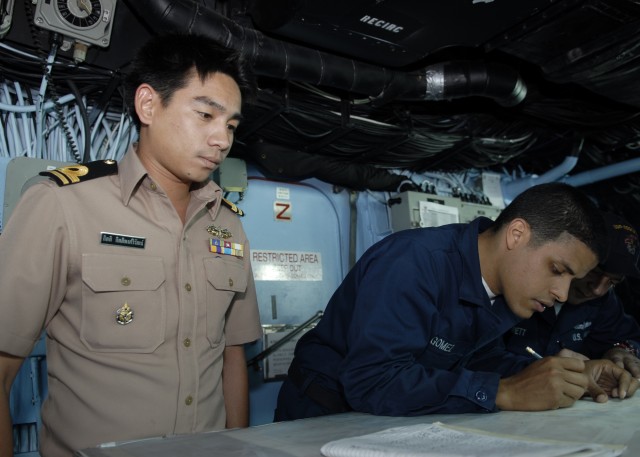GULF OF THAILAND - (February 8, 2009) - Sailors assigned to the forward-deployed amphibious assault ship USS Essex (LHD 2) conducted deck landing qualifications (DLQ) with their Royal Thai Navy (RTN) counterparts Feb. 8.
The qualifications were part of Cobra Gold 2009 (CG 09), a multinational exercise hosted annually by the Kingdom of Thailand.
Throughout the morning, RTN pilots practiced landing Seahawk S70-B and Super Lynx 300 helicopters on Essex' flight deck. According to Lt. Cmdr. Ben Sigurdson, Essex aircraft handling officer, the qualifications are essential to Essex' mission of promoting peace and stability in the Pacific region.
"Any time we have the opportunity to work with a foreign country we try to get their helicopters out here," said Sigurdson. "We are always looking to enhance our ability to assist our friends and allies throughout the Pacific."
This kind of training improves multinational interoperability, which makes it easier for Pacific nations to operate together if called upon during a real crisis, said Sigurdson.
"It really helps out if we would need to react to something in one of the countries in the region, such as respond to a natural disaster," he said. "Maintaining good relations and training with countries like Thailand allow us to respond to contingencies more effectively."
Many people in countries throughout the Pacific region have experienced major disasters, and servicemembers from both Thai and U.S. Navies agree that being constantly prepared to respond is crucial to humanitarian efforts.
"Combined training like this is very important to our efforts," said RTN Capt. Piya Ardmoongkun, an AV-8S Harrier jet aircraft pilot. "Who knows what is going to happen in the future' If something would happen and we really needed to rely on each other, this training will allow us to do that."
For the aircraft handlers on Essex' flight deck, a DLQ involving foreign pilots introduces an array of new challenges.
"There are some differences in the ways that each of us do things and you never know exactly how a pilot is going to react to those differences," said Senior Chief Aviation Boatswain's Mate (Handling) (AW/SW) Chris Brunson, Essex V-1 division leading chief petty officer. "The important thing is that we're ready to respond and I think we did a really good job of that today."
Despite each Navy's inherent differences, Essex' flight deck crew didn't miss a step, successfully completing dozens of landings throughout the three-hour operation.
"You have to take it really slow and you have to use standard signals to communicate, overall I think we did outstanding," said Aviation Boatswain's Mate (Handling) First Class (AW/SW) Giancarlo Treano.
While RTN pilots spent most of the morning accomplishing their DLQ goals, they didn't leave the ship without stopping by flight deck control to exchange some knowledge and culture with the Sailors who helped guide them to safe landings. Sigurdson said he spent some time getting to know the pilots and exchanging squadron patches and coins with them before they departed.
Essex is commanded by Capt. Brent Canady and is the lead ship of the only forward-deployed U.S. Expeditionary Strike Group and serves as the flagship for CTF 76, the Navy's only forward-deployed amphibious force commander. Task Force 76 is headquartered at White Beach Naval Facility, Okinawa, Japan with a detachment in Sasebo, Japan.
-30-




Social Sharing